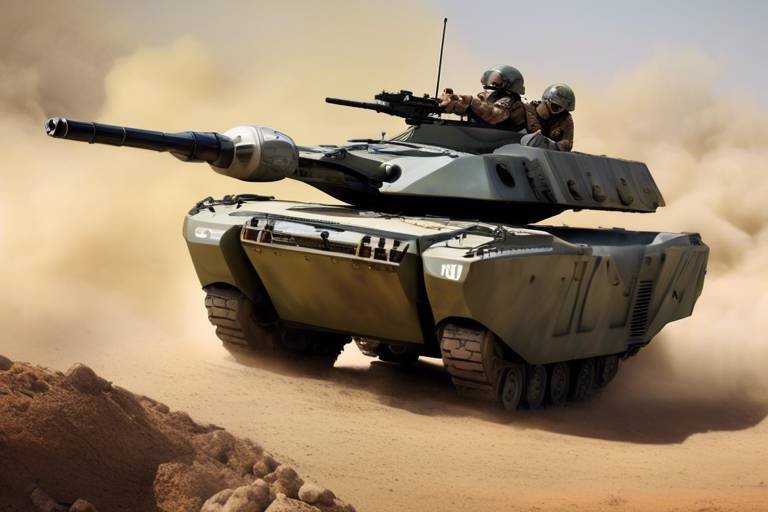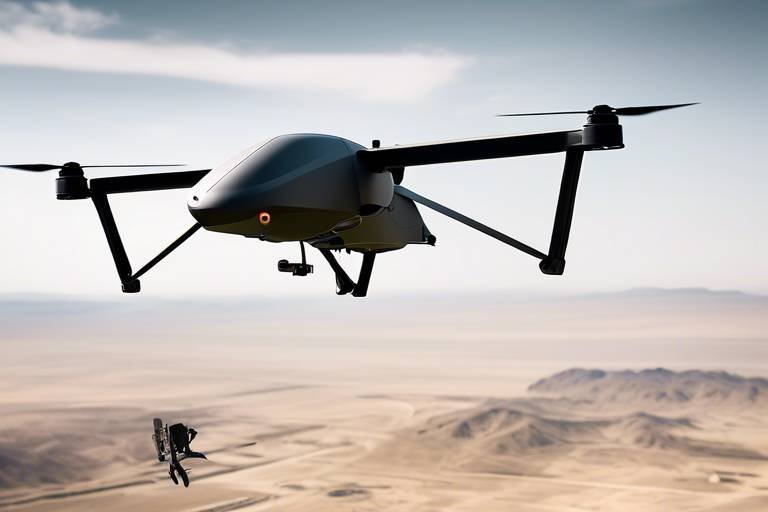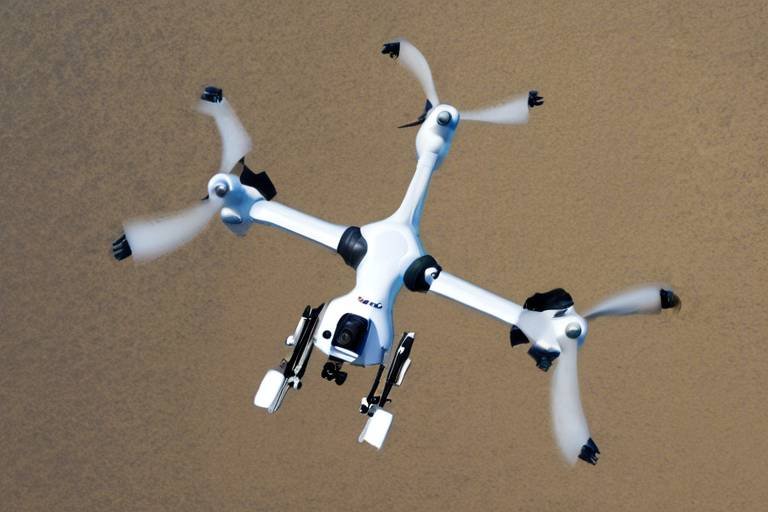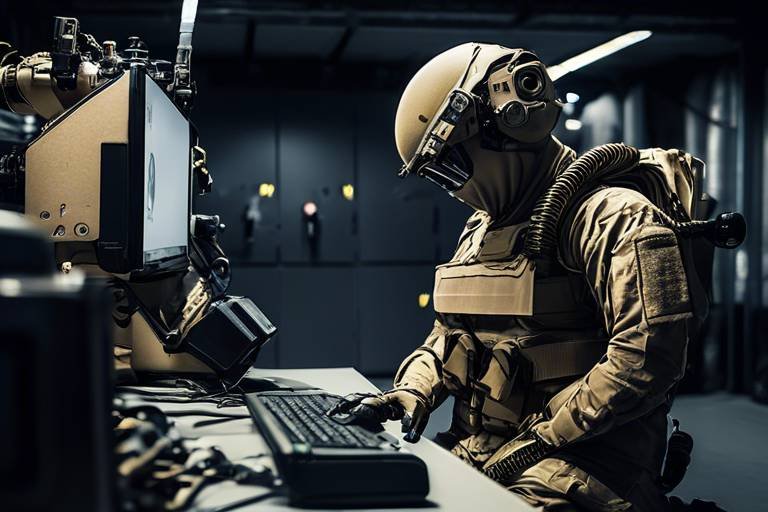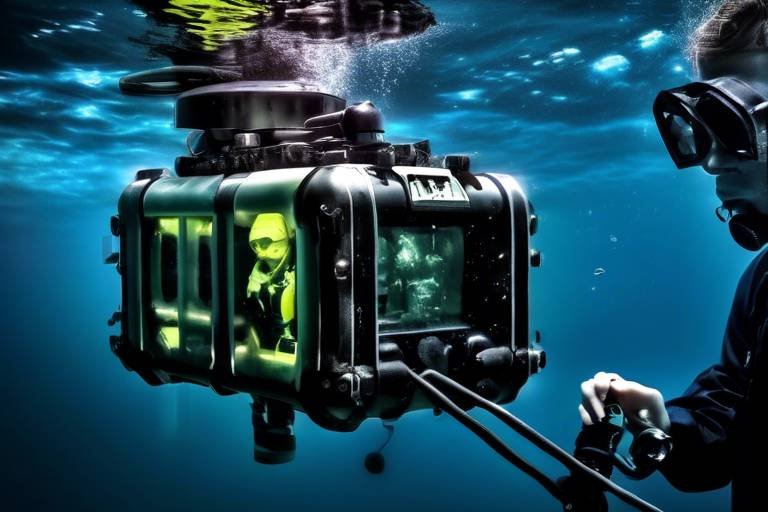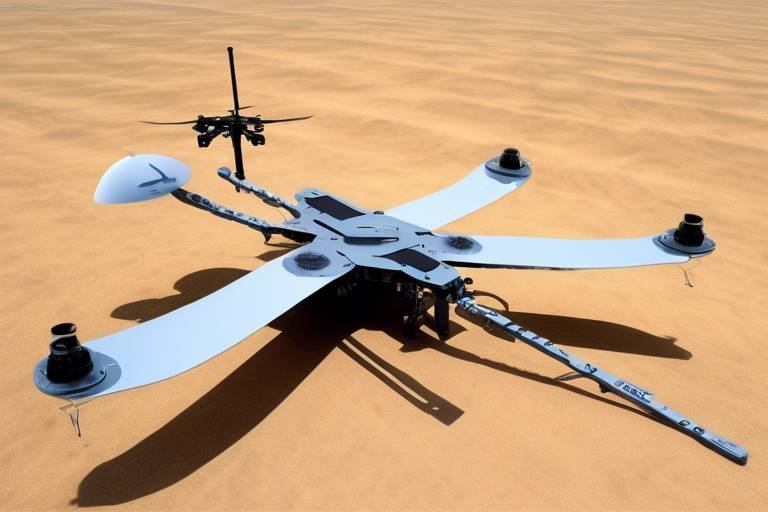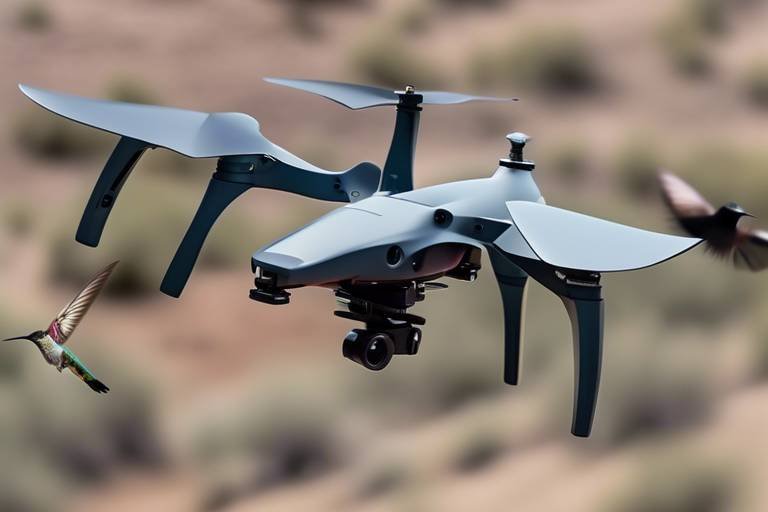Assessing the Effectiveness of the RQ-4B in Strategic Reconnaissance
The RQ-4B Global Hawk has revolutionized the way military forces conduct surveillance and reconnaissance missions. As a high-altitude, long-endurance unmanned aerial vehicle (UAV), it offers a unique combination of capabilities that make it an invaluable asset in modern warfare. Imagine having a bird's eye view of vast territories, gathering critical intelligence without putting personnel at risk. This is precisely what the RQ-4B brings to the table. Its advanced technology allows for real-time data collection and analysis, providing military strategists with the information they need to make informed decisions.
What sets the RQ-4B apart from other reconnaissance platforms is its ability to operate at altitudes of up to 60,000 feet, allowing it to fly above most weather systems and enemy defenses. This high-flying capability not only enhances its surveillance range but also minimizes the risk of detection and interception. The drone is equipped with sophisticated sensors, including synthetic aperture radar and electro-optical/infrared cameras, which enable it to capture high-resolution images and gather signals intelligence across vast areas.
The RQ-4B's operational history is a testament to its effectiveness in various conflicts and peacekeeping missions. From Afghanistan to Iraq, this drone has played a crucial role in gathering intelligence that has shaped military strategies and operations. Its ability to provide persistent surveillance means that commanders can maintain situational awareness over areas of interest, which is vital in today’s fast-paced combat environments.
However, the effectiveness of the RQ-4B is not without its challenges. As military technology evolves, so do the tactics employed by adversaries. The drone faces vulnerabilities that can compromise its mission effectiveness. For instance, electronic warfare techniques can disrupt its communication systems, making it susceptible to enemy countermeasures. Furthermore, the sheer volume of data generated by the RQ-4B can lead to information overload, complicating the analysis and decision-making processes.
Looking to the future, the potential for the RQ-4B remains promising. With ongoing advancements in sensor technology and data processing capabilities, we can expect this UAV to evolve further, enhancing its role in reconnaissance missions. As militaries around the world continue to adapt to new threats and operational needs, the RQ-4B will undoubtedly remain at the forefront of strategic reconnaissance, providing invaluable insights that guide military operations.
- What is the primary function of the RQ-4B Global Hawk?
The primary function of the RQ-4B is to conduct high-altitude, long-endurance reconnaissance missions, providing real-time intelligence to military commanders. - How does the RQ-4B differ from manned reconnaissance aircraft?
Unlike manned aircraft, the RQ-4B operates without a pilot onboard, allowing for extended missions without risking human lives. Its advanced sensors also provide enhanced surveillance capabilities. - What are the main challenges faced by the RQ-4B?
The RQ-4B faces challenges such as susceptibility to electronic warfare, vulnerabilities to enemy defenses, and data management issues due to the sheer volume of information it collects. - What advancements can we expect for the RQ-4B in the future?
Future advancements for the RQ-4B may include improved sensor technologies, enhanced data processing capabilities, and integration with other military systems for more effective reconnaissance.

Overview of the RQ-4B
The RQ-4B Global Hawk is not just any drone; it represents a significant leap in the realm of unmanned aerial vehicles (UAVs) designed specifically for strategic reconnaissance. This high-altitude, long-endurance UAV is engineered to cover vast distances while gathering crucial intelligence. Imagine a bird soaring high above the battlefield, silently observing and reporting back vital information without ever being detected. That's the essence of the RQ-4B's design.
One of the standout features of the RQ-4B is its impressive sensor suite. Equipped with advanced imaging systems, it can capture high-resolution images and gather signals intelligence from thousands of feet in the air. This capability allows military operators to maintain situational awareness over large areas, making it an indispensable tool in modern warfare. The drone's ability to fly at altitudes of up to 60,000 feet means it can stay above most weather conditions and enemy defenses, further enhancing its operational effectiveness.
Moreover, the RQ-4B is designed with a modular architecture, allowing for easy upgrades and modifications. This flexibility ensures that the drone can adapt to new technologies and mission requirements as they arise. For instance, the integration of cutting-edge data processing capabilities enables real-time analysis of the information collected, ensuring that commanders have access to timely and actionable intelligence. To put it simply, the RQ-4B is like a Swiss Army knife in the sky, equipped to handle a variety of reconnaissance tasks.
In terms of operational range, the RQ-4B can cover vast distances without needing to refuel, making it a game-changer for long-duration missions. Its endurance is a key factor that allows military forces to maintain continuous surveillance over critical areas, often for more than 30 hours at a time. This capability can be likened to having a watchful eye that never blinks, providing constant coverage and support to ground forces and decision-makers.
To summarize the RQ-4B's capabilities, here’s a quick overview:
| Feature | Description |
|---|---|
| Altitude | Up to 60,000 feet |
| Endurance | Over 30 hours |
| Payload | Advanced sensor suite for imaging and signals intelligence |
| Modularity | Easy upgrades and modifications |
In conclusion, the RQ-4B Global Hawk stands out as a remarkable technological achievement in the field of military reconnaissance. Its combination of high-altitude flight, long endurance, and advanced sensor capabilities makes it a vital asset for modern military operations. As we delve deeper into its operational history and technological advancements, we'll uncover just how impactful this drone has been in shaping military strategy and intelligence gathering.
- What is the primary function of the RQ-4B Global Hawk?
The RQ-4B is primarily used for strategic reconnaissance, gathering intelligence through advanced sensor technology. - How high can the RQ-4B fly?
The RQ-4B can operate at altitudes of up to 60,000 feet, allowing it to avoid most enemy defenses. - What makes the RQ-4B different from other drones?
Its long endurance, advanced sensor suite, and modular design set the RQ-4B apart from other UAVs. - How long can the RQ-4B stay in the air?
The RQ-4B can remain airborne for over 30 hours, providing continuous surveillance capabilities.

Operational History
The operational history of the RQ-4B Global Hawk is a testament to its remarkable capabilities in the realm of strategic reconnaissance. Since its introduction, the RQ-4B has been deployed in various conflicts and missions, showcasing its ability to gather vital intelligence and enhance situational awareness for military operations. Understanding these deployments not only highlights the drone's effectiveness but also underscores its pivotal role in shaping modern military strategy.
One of the most significant aspects of the RQ-4B's operational history is its involvement in key military campaigns. From the deserts of the Middle East to the complex terrains of Afghanistan, the Global Hawk has proven to be an invaluable asset. Its high-altitude, long-endurance capabilities allow it to cover vast areas without the need for frequent refueling, making it a game-changer in reconnaissance missions. The drone's ability to fly at altitudes of up to 60,000 feet enables it to evade many ground-based threats while capturing high-resolution imagery and signals intelligence.
Throughout its service, the RQ-4B has participated in numerous missions that have solidified its reputation as a strategic reconnaissance tool. Some of the key missions include:
- Operation Enduring Freedom
- Operation Iraqi Freedom
- Humanitarian Assistance Missions
Each of these missions has showcased the drone's unique capabilities, providing commanders with real-time intelligence that has been crucial for decision-making in fast-paced combat environments. The RQ-4B's ability to relay information back to command centers in near real-time has allowed military leaders to adapt their strategies swiftly, ensuring that they remain one step ahead of adversaries.
During Operation Enduring Freedom, the RQ-4B played a vital role in enhancing situational awareness across Afghanistan. The drone's advanced sensor suite enabled it to monitor enemy movements and gather intelligence on potential threats. This was particularly important in a landscape filled with hidden insurgent groups and complex terrains. With its ability to cover large areas, the RQ-4B provided a comprehensive view of the battlefield, allowing coalition forces to plan and execute operations with greater precision.
Similarly, in Operation Iraqi Freedom, the RQ-4B was instrumental in surveillance and reconnaissance efforts. The drone's high-altitude flights allowed it to observe troop movements and supply routes without being detected. This information was crucial for disrupting enemy operations and ensuring the safety of ground troops. The RQ-4B's contributions to intelligence gathering in Iraq not only aided in military operations but also played a role in the overall strategy of coalition forces.
In conclusion, the operational history of the RQ-4B Global Hawk illustrates its strategic importance in modern warfare. Its ability to provide real-time intelligence and situational awareness has made it a cornerstone of military reconnaissance efforts. As technology continues to evolve, the RQ-4B is likely to remain a key player in future military operations, adapting to meet the challenges of an ever-changing battlefield.
- What is the primary function of the RQ-4B Global Hawk?
The primary function of the RQ-4B is to conduct strategic reconnaissance missions, providing real-time intelligence and surveillance data to military commanders. - How high can the RQ-4B fly?
The RQ-4B can fly at altitudes of up to 60,000 feet, allowing it to evade many ground-based threats while capturing high-resolution imagery. - What are some key missions the RQ-4B has participated in?
The RQ-4B has been involved in several key missions, including Operation Enduring Freedom and Operation Iraqi Freedom, showcasing its capabilities in various conflict zones. - What challenges does the RQ-4B face in operational environments?
Some challenges include vulnerability to electronic warfare and data overload issues due to the vast amount of information it collects during missions.

Key Missions
The RQ-4B Global Hawk has proven itself as a formidable asset in various military operations, showcasing its capabilities in strategic reconnaissance across multiple theaters of conflict. Its ability to loiter for extended periods at high altitudes allows it to gather intelligence that is invaluable for mission planning and execution. Let’s delve into some of the most significant missions that highlight the RQ-4B's contributions to military strategy and intelligence gathering.
One of the standout missions of the RQ-4B occurred during Operation Enduring Freedom. In this campaign, the drone played a pivotal role in enhancing situational awareness for ground troops. By providing real-time imagery and intelligence, the RQ-4B helped commanders make informed decisions, significantly impacting operational outcomes. Its advanced sensors enabled it to detect enemy movements, assess battlefield conditions, and relay critical information back to command centers, all while remaining out of range of most enemy fire.
Another notable deployment was during Operation Iraqi Freedom. Here, the RQ-4B further solidified its reputation as a key player in reconnaissance missions. Operating in a complex environment filled with urban landscapes and hostile forces, the drone's ability to conduct persistent surveillance allowed for the identification of insurgent activities and the monitoring of key infrastructure. The insights gained from these missions not only aided in immediate tactical operations but also contributed to long-term strategic planning.
| Operation | Year | Key Contributions |
|---|---|---|
| Operation Enduring Freedom | 2001 - Present | Enhanced situational awareness, real-time intelligence gathering |
| Operation Iraqi Freedom | 2003 - 2011 | Persistent surveillance, insurgent activity monitoring |
These missions underscore the RQ-4B's strategic importance in modern warfare. Its ability to operate autonomously over vast distances while collecting critical data has transformed how military operations are conducted. The drone's contributions extend beyond immediate tactical advantages; they also shape broader military strategies by providing insights that inform future operations.
As we analyze these missions, it becomes clear that the RQ-4B is not just a tool for surveillance; it is a game changer in the realm of military intelligence. The lessons learned from its deployments continue to influence how armed forces approach reconnaissance and operational planning, ensuring that the RQ-4B remains a vital asset for years to come.
- What is the primary function of the RQ-4B Global Hawk?
The RQ-4B is primarily designed for high-altitude, long-endurance surveillance and reconnaissance missions. - How does the RQ-4B enhance situational awareness?
By providing real-time imagery and data, the RQ-4B enables military commanders to make informed decisions during operations. - What are some challenges faced by the RQ-4B?
Challenges include vulnerability to enemy countermeasures and data overload issues, which can complicate information analysis. - What is the future potential of the RQ-4B?
The future of the RQ-4B looks promising with potential advancements in technology that could enhance its capabilities in modern warfare.

Operation Enduring Freedom
The RQ-4B Global Hawk played a pivotal role in , which commenced in 2001 as a response to the September 11 attacks. This operation was not just a military engagement; it represented a new era in warfare where intelligence, surveillance, and reconnaissance (ISR) became vital components of military strategy. The Global Hawk's ability to fly at high altitudes for extended periods allowed it to cover vast areas of interest, providing commanders with real-time intelligence that was previously unattainable.
One of the most significant advantages of the RQ-4B during this operation was its advanced sensor technology. Equipped with high-resolution cameras and synthetic aperture radar, the drone could gather detailed imagery and data on enemy positions and movements. This capability ensured that military leaders had access to critical information, allowing for more informed decision-making. Imagine having an eagle's eye view of the battlefield, spotting threats before they could become a problem—that's precisely what the RQ-4B offered.
Throughout Operation Enduring Freedom, the RQ-4B was deployed to monitor key regions, including Afghanistan and surrounding areas. Its contributions can be summarized in several key areas:
- Intelligence Gathering: The drone's high-altitude flights enabled it to collect data from enemy camps and supply routes, significantly enhancing situational awareness.
- Force Protection: By providing near real-time surveillance, the RQ-4B helped protect ground troops from ambushes and surprise attacks.
- Target Identification: The drone's capabilities allowed for precise target identification, which was crucial for airstrikes and ground operations.
Moreover, the RQ-4B's ability to transmit data back to command centers in real-time facilitated a rapid response to emerging threats. This was particularly important in a dynamic combat environment where situations could change in an instant. The drone's contributions were not just limited to gathering information; it also played a crucial role in coordinating air support and ensuring that operations were executed with maximum efficiency.
However, the operation was not without its challenges. As the RQ-4B flew deep into hostile territories, it faced the constant threat of enemy defenses. Yet, despite these risks, its operational success during Operation Enduring Freedom showcased the importance of integrating advanced technology into military strategies. The lessons learned from this operation have continued to influence how reconnaissance missions are conducted in modern warfare.
In conclusion, the RQ-4B's involvement in Operation Enduring Freedom underscores its significance in strategic reconnaissance. By providing unparalleled surveillance capabilities, it has transformed the way military operations are planned and executed, proving that in the realm of warfare, knowledge truly is power.
- What is the RQ-4B Global Hawk?
The RQ-4B Global Hawk is an unmanned aerial vehicle (UAV) designed for high-altitude, long-endurance surveillance missions. - How did the RQ-4B contribute to Operation Enduring Freedom?
It provided real-time intelligence, enhanced situational awareness, and supported ground troops by identifying targets and monitoring enemy movements. - What are the main technologies used in the RQ-4B?
The RQ-4B is equipped with advanced sensors, including high-resolution cameras and synthetic aperture radar, which enable detailed reconnaissance. - What challenges does the RQ-4B face in operations?
It faces vulnerabilities to enemy defenses and the complexities of managing large amounts of data collected during missions.

Operation Iraqi Freedom
The RQ-4B Global Hawk played a pivotal role during , which commenced in March 2003. This military campaign was aimed at dismantling the regime of Saddam Hussein and ensuring the safety of the Iraqi people. The Global Hawk, with its advanced surveillance capabilities, provided crucial intelligence that shaped military strategies and operations on the ground.
One of the standout features of the RQ-4B during this operation was its ability to conduct high-altitude reconnaissance over vast areas, collecting real-time data that was essential for decision-makers. Unlike traditional aircraft, the Global Hawk could remain airborne for extended periods, often exceeding 30 hours, allowing it to cover large swathes of territory without the need for frequent refueling. This capability meant that commanders had access to continuous surveillance, which was vital in a rapidly changing battlefield environment.
Throughout the operation, the RQ-4B was tasked with several critical missions, including:
- Monitoring troop movements: The drone's high-resolution cameras and sensors allowed it to track enemy movements, providing invaluable information that helped in planning ground assaults.
- Identifying potential threats: By analyzing signals intelligence, the Global Hawk helped to pinpoint locations of enemy forces and equipment, reducing the risk to allied troops.
- Supporting ground forces: The real-time data gathered by the RQ-4B enabled ground units to make informed decisions, ensuring that they could respond quickly to emerging threats.
Moreover, the RQ-4B's ability to integrate various sensor technologies, such as synthetic aperture radar (SAR) and electro-optical/infrared (EO/IR) systems, enhanced its effectiveness. This combination of technologies provided a comprehensive view of the battlefield, allowing for better situational awareness and intelligence gathering.
However, the operation was not without its challenges. The RQ-4B faced threats from enemy anti-aircraft systems and electronic warfare tactics. Adversaries quickly adapted to the drone's capabilities, which led to an ongoing game of cat and mouse in terms of tactics and countermeasures. Despite these challenges, the RQ-4B remained a cornerstone of the U.S. military's reconnaissance strategy, demonstrating the importance of unmanned systems in modern warfare.
In conclusion, the RQ-4B's contributions to Operation Iraqi Freedom exemplified its role as a force multiplier in military operations. By providing critical intelligence and enhancing situational awareness, the Global Hawk significantly impacted the effectiveness of U.S. and coalition forces in Iraq.
- What is the RQ-4B Global Hawk? The RQ-4B Global Hawk is a high-altitude, long-endurance unmanned aerial vehicle used primarily for reconnaissance and surveillance.
- How does the RQ-4B gather intelligence? It employs advanced sensors, cameras, and radar systems to collect real-time data on enemy movements and battlefield conditions.
- What were the key missions of the RQ-4B during Operation Iraqi Freedom? The drone was involved in monitoring troop movements, identifying threats, and supporting ground forces with critical intelligence.
- What challenges did the RQ-4B face during the operation? The RQ-4B faced threats from enemy anti-aircraft systems and electronic warfare tactics, which required ongoing adaptations in tactics.

Technological Advancements
The RQ-4B Global Hawk is not just a drone; it is a marvel of modern engineering that embodies the pinnacle of in unmanned aerial vehicles (UAVs). With its sophisticated design, the RQ-4B has revolutionized the way military forces gather intelligence, conduct surveillance, and maintain situational awareness over vast expanses. One of the most notable features of the RQ-4B is its cutting-edge sensor technology, which includes high-resolution electro-optical/infrared (EO/IR) cameras, synthetic aperture radar (SAR), and signals intelligence (SIGINT) capabilities. These sensors work in harmony to provide comprehensive and actionable intelligence that can be pivotal in military operations.
Imagine having a bird's eye view that not only captures stunning images but also interprets them in real-time. The RQ-4B can fly at altitudes exceeding 60,000 feet, well above the range of most enemy defenses. This altitude advantage allows it to cover vast areas while remaining largely undetected. The drone’s ability to loiter for extended periods—up to 34 hours—means it can collect data continuously, giving commanders a persistent view of the battlefield. The integration of advanced data processing capabilities further enhances its effectiveness. The RQ-4B utilizes onboard processing to filter and analyze data before transmitting it back to command centers, ensuring that only the most relevant information reaches decision-makers.
Moreover, the RQ-4B's communication systems are state-of-the-art, enabling secure and reliable data transfer over significant distances. This capability is crucial for real-time decision-making, allowing military leaders to respond swiftly to emerging threats. The drone can transmit high-definition imagery and other intelligence data through satellite links, ensuring that information is available to ground forces and command units without delay. In essence, the RQ-4B serves as an eye in the sky, offering a level of situational awareness that was previously unimaginable.
However, the technological advancements of the RQ-4B are not limited to its hardware. The software that powers its operations is equally sophisticated. Advanced algorithms analyze incoming data streams, identifying patterns and anomalies that human operators might miss. This artificial intelligence (AI) aspect significantly enhances the drone's operational efficiency, allowing it to prioritize targets and streamline the intelligence-gathering process.
As we look to the future, the RQ-4B is poised for even more advancements. Ongoing research and development aim to integrate next-generation technologies such as autonomous flight capabilities and improved stealth features, which would further enhance its survivability and operational effectiveness. The potential for incorporating machine learning into its systems could revolutionize how the RQ-4B analyzes data, making it an even more formidable asset in military strategy.
In summary, the RQ-4B Global Hawk is not merely a tool for reconnaissance; it is a sophisticated platform that combines advanced sensors, robust communication systems, and cutting-edge software to deliver unparalleled intelligence capabilities. Its technological advancements have not only transformed military operations but also set the stage for future innovations in unmanned aerial systems.
- What is the maximum altitude of the RQ-4B Global Hawk? The RQ-4B can fly at altitudes exceeding 60,000 feet.
- How long can the RQ-4B stay in the air? The RQ-4B can loiter for up to 34 hours, providing extended surveillance capabilities.
- What types of sensors are equipped on the RQ-4B? It includes high-resolution EO/IR cameras, synthetic aperture radar (SAR), and signals intelligence (SIGINT) systems.
- How does the RQ-4B transmit data? The drone uses advanced communication systems to securely transmit data via satellite links.
- What are the future advancements expected for the RQ-4B? Future advancements may include autonomous flight capabilities and improved stealth features.

Challenges Faced
The RQ-4B Global Hawk, while a marvel of modern technology, is not without its challenges. As the landscape of warfare evolves, so too do the threats that unmanned aerial vehicles (UAVs) like the RQ-4B must navigate. One of the primary concerns is its vulnerability to enemy defenses. Despite its advanced design and capabilities, the drone is not impervious to detection and engagement by sophisticated anti-aircraft systems. This vulnerability can significantly limit its operational effectiveness, especially in contested environments where adversaries are equipped with advanced electronic warfare capabilities.
Moreover, the RQ-4B faces the daunting challenge of data overload. With its ability to collect vast amounts of intelligence data, the drone can produce an overwhelming volume of information. This influx can lead to complications in real-time data analysis and decision-making. Military strategists and analysts must sift through this mountain of data to extract actionable insights, a process that can be both time-consuming and prone to human error. The struggle to manage and utilize this data effectively is a pressing issue that can hinder the RQ-4B's contributions to military operations.
To illustrate the challenges faced by the RQ-4B, consider the following table, which summarizes its operational limitations:
| Challenge | Description |
|---|---|
| Vulnerability to Countermeasures | Exposed to electronic warfare and advanced anti-aircraft systems that can detect and engage UAVs. |
| Data Overload | Massive amounts of data collected can overwhelm analysts, leading to potential information paralysis. |
| Operational Limitations | Weather conditions and technical malfunctions can impact flight operations and data collection. |
In addition to these challenges, the RQ-4B must also contend with operational limitations stemming from environmental factors. Weather conditions such as heavy rain, fog, or high winds can disrupt its flight paths and data gathering capabilities. Moreover, technical malfunctions, while rare, can occur and potentially compromise missions. These limitations necessitate careful planning and execution to ensure that the RQ-4B can operate effectively in various scenarios.
As the military continues to rely on UAVs like the RQ-4B for strategic reconnaissance, addressing these challenges will be crucial. Continuous advancements in technology, training, and operational tactics will help mitigate vulnerabilities and enhance the overall effectiveness of the RQ-4B in future missions.
- What is the primary purpose of the RQ-4B Global Hawk? The RQ-4B is primarily designed for high-altitude, long-endurance surveillance and reconnaissance missions.
- How does the RQ-4B handle data collection? The RQ-4B collects vast amounts of data through advanced sensors, but managing this data effectively poses significant challenges.
- What are the main threats to the RQ-4B? Its main threats include advanced anti-aircraft systems and electronic warfare tactics employed by adversaries.
- Can the RQ-4B operate in adverse weather conditions? While it has some capabilities, severe weather can limit its operational effectiveness.

Vulnerability to Countermeasures
The RQ-4B Global Hawk, while a marvel of modern engineering, is not without its vulnerabilities. As the landscape of warfare evolves, so too do the tactics employed by adversaries. The drone's reliance on sophisticated technology makes it susceptible to various countermeasures that can undermine its effectiveness in reconnaissance missions. One of the primary concerns is its vulnerability to electronic warfare, where adversaries deploy jamming techniques to disrupt the drone's communication and navigation systems. Imagine trying to listen to your favorite song on a radio, only to have static drown out the melody—this is akin to what happens to the RQ-4B when it encounters electronic interference.
Moreover, the drone's high-altitude flight capabilities, while advantageous for surveillance, also make it a target for advanced anti-aircraft systems. These systems are designed to detect, track, and engage aerial threats, and as technology progresses, the effectiveness of such systems continues to improve. The RQ-4B's large wingspan and distinctive shape, which contribute to its impressive surveillance capabilities, can also make it easier for enemy radar systems to identify and target. In essence, the very features that enhance its reconnaissance abilities can also serve as a double-edged sword.
To further illustrate these vulnerabilities, consider the following table that summarizes the key countermeasures and their impact on the RQ-4B:
| Countermeasure | Description | Impact on RQ-4B |
|---|---|---|
| Electronic Jamming | Disruption of communication and navigation signals. | Loss of control and situational awareness. |
| Cyber Attacks | Targeting the drone's software and data systems. | Potential for data theft or system malfunction. |
| Advanced Radar Systems | Detection and tracking of aerial targets. | Increased risk of interception by anti-aircraft systems. |
| Missile Systems | Use of surface-to-air missiles (SAMs) to engage aerial threats. | Direct threat to the drone's operational safety. |
These vulnerabilities highlight a critical aspect of modern warfare: the ongoing cat-and-mouse game between reconnaissance technology and countermeasures. As the RQ-4B continues to play a vital role in military operations, its designers and operators must remain vigilant and proactive in addressing these challenges. This involves not only enhancing the drone's technological capabilities but also adapting tactics to minimize exposure to threats. In this way, the RQ-4B can maintain its edge in the ever-evolving battlefield landscape.
- What makes the RQ-4B vulnerable to electronic warfare? The RQ-4B relies heavily on its communication and navigation systems, which can be disrupted by jamming techniques used by adversaries.
- How does the RQ-4B's altitude affect its vulnerability? While flying at high altitudes allows for broad surveillance coverage, it also makes the drone more detectable by advanced radar systems, increasing the risk of interception.
- What are the implications of cyber attacks on the RQ-4B? Cyber attacks can compromise the drone's software, potentially leading to data theft or operational failures, which could significantly hinder its reconnaissance capabilities.

Data Overload Issues
The RQ-4B Global Hawk is a technological marvel, capable of gathering vast amounts of intelligence from the skies. However, this impressive capability comes with its own set of challenges—most notably, the issue of data overload. Imagine trying to drink from a fire hose; that’s the kind of deluge of information that operators can face when the RQ-4B is in action. With its array of advanced sensors, the drone can collect data on everything from troop movements to environmental conditions, resulting in an overwhelming volume of information that can be difficult to sift through.
One of the primary concerns with data overload is the time-sensitive nature of military operations. In fast-paced scenarios, commanders need actionable intelligence quickly. However, when faced with an avalanche of data, the risk of missing critical insights increases significantly. This is akin to searching for a needle in a haystack; the more hay you have, the harder it is to find that needle. To mitigate this, the military employs various data processing techniques, but the challenge remains daunting.
Moreover, the RQ-4B's ability to capture high-resolution imagery and extensive signals intelligence means that operators often have to deal with multiple data formats. This diversity can complicate the analysis process. For instance, combining satellite imagery with electronic signals requires sophisticated algorithms and skilled personnel, who must be able to interpret and correlate information from different sources effectively. The complexity of the data can lead to misinterpretations, which can have serious ramifications in the field.
To address these challenges, the military is exploring innovative solutions. One approach is the use of artificial intelligence (AI) and machine learning algorithms to automate data analysis. By leveraging AI, analysts can filter out irrelevant information and focus on what truly matters. This not only speeds up the decision-making process but also enhances the overall effectiveness of the RQ-4B in reconnaissance missions. However, the integration of such technologies is still in its infancy, and there are concerns regarding reliability and the potential for errors in AI judgments.
In summary, while the RQ-4B is a powerful tool for intelligence gathering, the issue of data overload poses significant challenges. The military must continuously adapt and innovate to ensure that the wealth of information collected can be transformed into actionable intelligence swiftly and accurately. The future of reconnaissance may very well depend on how effectively these challenges are addressed.
- What is data overload in the context of the RQ-4B?
Data overload refers to the overwhelming amount of information collected by the RQ-4B, which can complicate analysis and decision-making. - How does the military address data overload issues?
The military is exploring the use of AI and machine learning to automate data analysis and improve the speed and accuracy of intelligence processing. - What types of data does the RQ-4B collect?
The RQ-4B collects various types of data, including high-resolution imagery, signals intelligence, and environmental information. - Why is timely intelligence important in military operations?
Timely intelligence is crucial for making informed decisions that can impact the success of military missions and the safety of personnel.

Future Potential and Developments
The future of the RQ-4B Global Hawk is not just a continuation of its current capabilities; it is a thrilling journey into the realm of advanced military technology. As the landscape of warfare evolves, so too does the need for sophisticated reconnaissance tools. The RQ-4B is poised to adapt and innovate, ensuring it remains at the forefront of military operations. With ongoing advancements in sensors, data processing, and autonomy, the RQ-4B is set to enhance its role in strategic reconnaissance significantly.
One of the most exciting prospects for the RQ-4B is the integration of artificial intelligence (AI) into its operational framework. Imagine a drone that not only collects vast amounts of data but also processes and analyzes that information in real-time. This capability could revolutionize decision-making on the battlefield, allowing commanders to respond to threats with unparalleled speed and accuracy. Moreover, AI could help the RQ-4B identify patterns and anomalies in data, making it an invaluable asset for intelligence agencies.
Additionally, advancements in sensor technology are on the horizon. Future iterations of the RQ-4B may feature enhanced imaging systems, capable of capturing high-resolution images even in adverse weather conditions. The incorporation of multi-spectral sensors could provide a more comprehensive view of the battlefield, facilitating better-targeted operations. With these enhancements, the RQ-4B will not only improve its reconnaissance capabilities but also support joint operations with other military assets.
Furthermore, as military engagements become more complex, the RQ-4B will likely see an expansion in its operational roles. From cyber warfare to humanitarian missions, the drone's versatility will be crucial. The ability to conduct real-time surveillance in urban environments, for instance, will be invaluable for both combat operations and peacekeeping missions. The RQ-4B's future is not limited to traditional warfare; it is likely to play a significant role in the evolving landscape of global security.
To put it simply, the RQ-4B Global Hawk is not just a tool of the past; it is a beacon of future potential. With each technological advancement, it becomes more capable of meeting the challenges of modern warfare. The military's investment in enhancing this drone reflects a commitment to maintaining a strategic advantage in an ever-changing world.
- What is the RQ-4B Global Hawk?
The RQ-4B Global Hawk is a high-altitude, long-endurance unmanned aerial vehicle designed primarily for surveillance and reconnaissance purposes.
- How does AI improve the RQ-4B's capabilities?
AI enhances the RQ-4B by enabling real-time data analysis, allowing for quicker decision-making and improved situational awareness on the battlefield.
- What advancements are expected in sensor technology?
Future advancements may include high-resolution imaging systems and multi-spectral sensors that provide comprehensive battlefield insights, even in challenging conditions.
- Can the RQ-4B be used for purposes other than military operations?
Yes, the RQ-4B has potential applications in humanitarian missions and disaster response, showcasing its versatility beyond traditional military engagements.
Frequently Asked Questions
- What is the RQ-4B Global Hawk?
The RQ-4B Global Hawk is a high-altitude, long-endurance unmanned aerial vehicle (UAV) designed primarily for surveillance and reconnaissance missions. Its advanced technology allows it to gather vast amounts of data over large areas, making it a critical asset for military operations.
- How does the RQ-4B enhance strategic reconnaissance?
The RQ-4B enhances strategic reconnaissance through its sophisticated sensor technology and data processing capabilities. It can operate at high altitudes, providing a bird's-eye view of the battlefield, and its long endurance allows it to stay airborne for extended periods, continuously collecting intelligence.
- What are some key missions the RQ-4B has been involved in?
The RQ-4B has played significant roles in various military operations, including Operation Enduring Freedom and Operation Iraqi Freedom. In these missions, it provided crucial situational awareness and intelligence, helping commanders make informed decisions on the ground.
- What challenges does the RQ-4B face in operational environments?
Despite its advantages, the RQ-4B faces challenges such as vulnerability to enemy countermeasures, including electronic warfare tactics. Additionally, the sheer volume of data it collects can lead to information overload, complicating analysis and decision-making processes.
- What advancements are expected for the RQ-4B in the future?
The future of the RQ-4B looks promising, with anticipated technological enhancements that could improve its reconnaissance capabilities even further. These developments may include upgraded sensors, better data processing systems, and advanced counter-countermeasure technologies to enhance its effectiveness in modern warfare.




